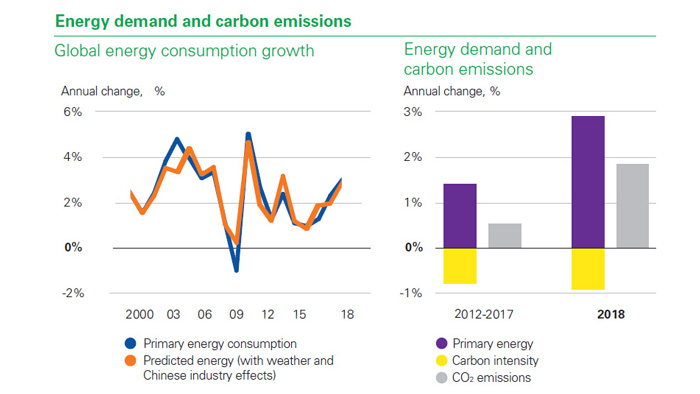
BP’s Statistical Review of World Energy highlights slow progress in reducing carbon emissions
BP released the 68th annual edition of the BP Statistical Review of World Energy, the most comprehensive collection and analysis of global energy data, early this week.
This year’s edition highlights the growing divergence between demands for action on climate change and the actual pace of progress on reducing carbon emissions.
Key findings from the BP Statistical Review 2019 include:
- Global energy demand grew by 2.9% and carbon emissions grew by 2.0% in 2018, faster than at any time since 2010-11.
- Renewables grew by 14.5%, nearing their record-breaking increase in 2017, but this still accounted for only around a third of the increase in total power generation.
- Natural gas consumption and production were up by more than 5%, one of the strongest rates of growth for both demand and output for more than 30 years.
- Coal consumption (+1.4%) and production (+4.3%) increased for the second year in a row in 2018, following three years of decline (2014-2016).
- The United States recorded the largest-ever annual production increases by any country for both oil and natural gas, the vast majority of increases coming from onshore shale plays.
Energy demand growth was largely driven by China, the U.S., and India which together accounted for around two-thirds of global growth. Relative to recent historical averages, the most striking growth was in the U.S., where energy consumption increased by 3.5%, the fastest growth seen for 30 years and in sharp contrast to the trend decline seen over the previous 10 years.
Much of the surprising strength in energy consumption in 2018 may be related to weather effects, according to BP. In particular, there was an unusually large number of hot and cold days across many of the world’s major demand centres last year, particularly in the U.S., China and Russia, with the increased demand for cooling and heating services helping to explain the strong growth in energy consumption in each of these countries.
The strength in energy consumption was pretty much reflected across all the fuels, most of which grew more strongly than their historical averages. This acceleration was particularly pronounced in natural gas demand, which increased 5.3%, one of its strongest growth rates for over 30 years, accounting for almost 45% of the entire growth in global energy consumption. Coal demand (1.4%) also increased for the second consecutive year, following three years of decline. Growth in renewable energy (14.5%) eased back slightly relative to past trends, although remained by far the world’s fastest growing energy source.
The power sector is the single largest source of carbon emissions within the energy system and needs to play a central role in any transition to a low carbon energy system. Global power demand grew by 3.7% last year, which is one of the strongest growth rates seen for 20 years, absorbing around half of the growth in primary energy. The developing world continued to drive the vast majority (81%) of this growth, led by China and India who together accounted for around two-thirds of the increase in power demand. But the particularly strong growth of power demand in 2018 owed much to the U.S., where power demand grew by a bumper 3.7%, boosted by those weather effects.
On the supply side, the growth in power generation was led by renewable energy, which grew by 14.5%, contributing around a third of the growth; followed by coal (3.0%) and natural gas (3.9%). China continued to lead the way in renewables growth, accounting for 45% of the global growth in renewable power generation, more than the entire OECD combined.
Despite the increasing penetration of renewable power, the fuel mix in the global power system remains flat, with the shares of both non-fossil fuels (36%) and coal (38%) in 2018 unchanged from their levels 20 years ago. A shift towards greater electrification helps as a pathway to a lower carbon energy system only if it goes hand-in-hand with a decarbonization of the power sector, the BP report emphasized. “Electrification without decarbonizing power is of little use,” the report said. Having said that, carbon emissions from the power sector are estimated to have increased by 2.7% in 2018, their highest rate of growth for seven years, accounting for around half of the growth in global carbon emissions.
Introducing the findings for 2018, Spencer Dale, BP chief economist, said: “There is a growing mismatch between societal demands for action on climate change and the actual pace of progress, with energy demand and carbon emissions growing at their fastest rate for years. The world is on an unsustainable path.”
“The longer carbon emissions continue to rise, the harder and more costly will be the necessary eventual adjustment to net-zero carbon emissions,” concluded Bob Dudley, BP group chief executive. “As I have said before, this is not a race to renewables, but a race to reduce carbon emissions across many fronts.”
The BP Statistical Review of World Energy and other related materials are available online at www.bp.com/statisticalreview.









